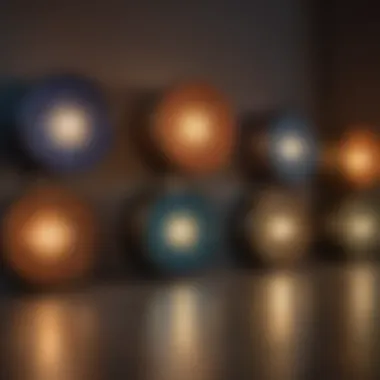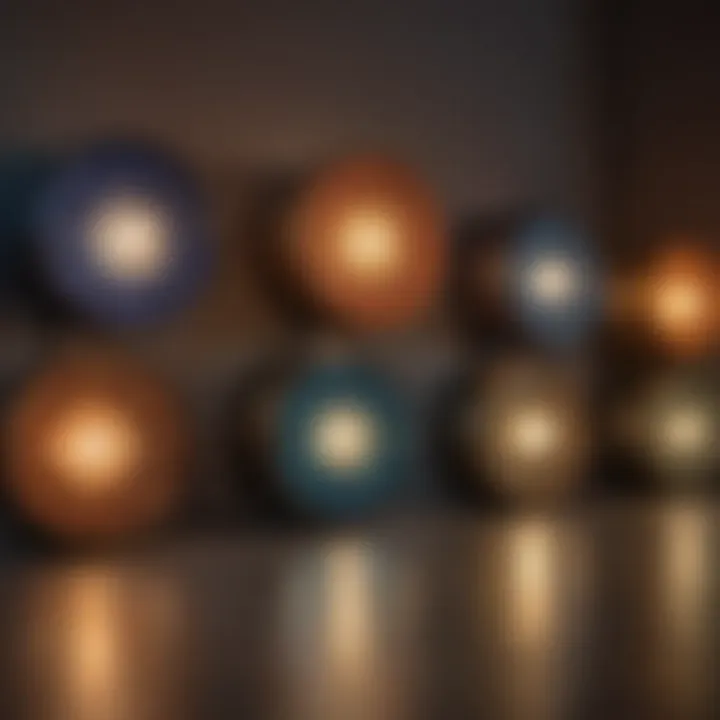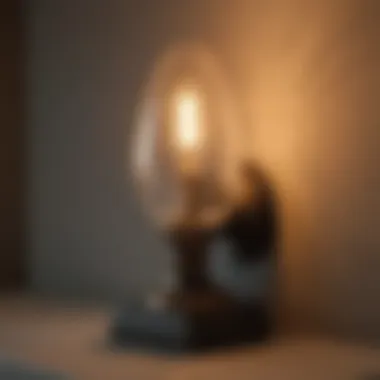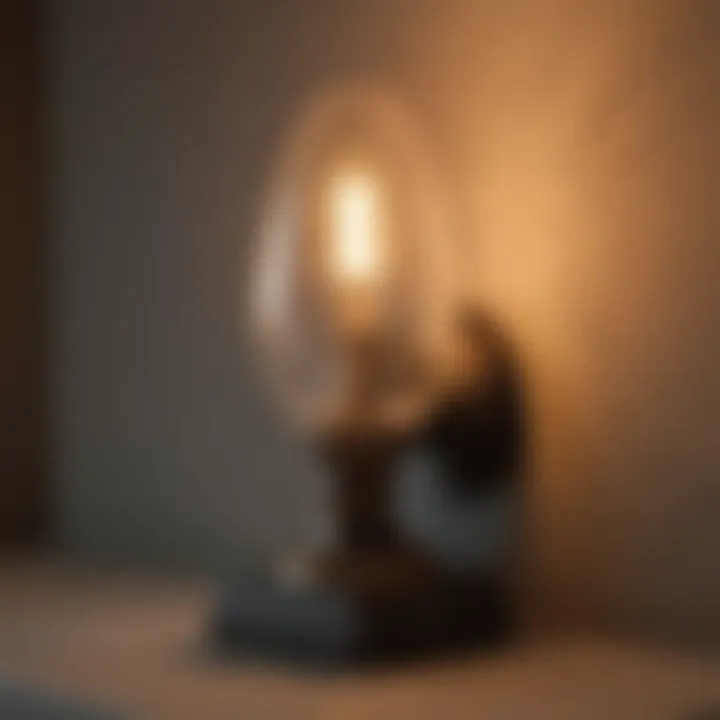The Benefits of Small Night Lights in Bedrooms


Intro
In contemporary bedroom design, small night lights are more than mere accessories. They serve crucial functions that extend beyond mere illumination. Integrating these features into bedroom spaces can dramatically affect ambiance, aesthetic appeal, and overall wellness. Understanding the various aspects of small night lights can help homeowners and renters alike in creating a more comfortable and conducive sleep environment. This article examines the utility of small night lights, focusing on aspects such as design, energy efficiency, psychological effects, and practical tips for selection and placement.
Trending Styles
Modern Minimalism
Modern minimalism is a rising trend in bedroom decor. Within this style, simplicity reigns supreme. Small night lights that feature clean lines and neutral tones complement minimalist spaces beautifully. These lights often utilize LED technology, offering energy efficiency without sacrificing style. They can seamlessly fit into various corners of the room, providing just the right touch of illumination.
Cozy Rustic
On the other end, the cozy rustic style embraces warmth and charm. Rustic small night lights often feature natural materials like wood and metal. They can deliver a soft glow that evokes comfort, making them ideal for winding down after a long day. Whether placed on a bedside table or mounted on walls, these lights enhance the organic feel of the bedroom.
Color Palettes
Calming Neutrals
When selecting small night lights, color plays a critical role. Calming neutral tones like beige, soft gray, and off-white create a serene atmosphere. These shades allow for easy integration into existing decor. Furthermore, they promote relaxation, essential for a peaceful night’s sleep. Choosing night lights in these colors can help establish a harmonious environment.
Bold Accents
Conversely, bold accents can add a distinctive flair to bedroom design. Night lights in vibrant colors can create focal points in a room. The strategic placement of these accents can enliven a space, promoting an uplifting atmosphere. Designers often recommend pairing bold night lights with more subdued elements for an appealing balance.
Small night lights serve functional roles while contributing aesthetically to your bedroom. Finding the perfect style and color can create a personal sanctuary where one can relax and recharge.
By considering trends and color choices, there's potential to elevate the design of the bedroom. The following sections will delve deeper into factors like energy efficiency, psychological effects, and practical selection tips.
Prelude to Night Lighting
Night lighting in the bedroom is significant for various reasons. It allows for a soothing transition from day to night, enabling relaxation and comfort. Night lights serve a practical purpose, providing a gentle illumination that can guide individuals during nighttime awakenings without fully waking them. This creates a balance between functionality and aesthetics.
Moreover, the right kind of night light can enhance the room's overall design. It serves not just as a light source but also as a decorative element. Overall, incorporating night lights into bedroom designs can provide solutions that cater to safety, ambiance, and personal preference.
Definition and Purpose
A night light can be defined as a low-intensity light source that remains on during the night. Its purpose extends beyond merely giving light. Night lights are primarily used to facilitate movement during nighttime, reduce the fear of darkness, and foster a calming environment, especially for children. Many individuals appreciate the soft glow of night lights, as they can ease anxiety and promote a sense of security.
Different types of night lights might serve unique purposes. For example, a plug-in night light can be directly connected to an electrical outlet and turned on automatically in the dark, while battery-operated versions provide flexibility and can be placed anywhere. The market even offers smart night lights that connect to home networks, providing control through applications on smartphones.
Historical Context
The concept of night lighting has existed for centuries. Historically, candles and oil lamps were the primary sources of light during nighttime. These methods of illumination were often impractical and posed safety risks, particularly in homes. With technological advancements, incandescent light bulbs replaced these older systems, as they were more efficient and safer to use.
In recent years, the surge of LED technology has revolutionized the design and function of night lights. LEDs are energy-efficient and offer varying color temperatures, allowing consumers to choose lights that align with their preferences and needs. As a result, small night lights have become a staple in many households, addressing both practical needs and a desire for a more inviting atmosphere within personal spaces.
In summary, the exploration of night lighting within bedroom environments is multifaceted. It offers insights into not just the functionality of these lights but also their role in design and historical development.
Types of Small Night Lights
Understanding the different types of small night lights is crucial. Each kind serves unique purposes, catering to various needs and preferences. This knowledge allows homeowners to select the most suitable option for their bedroom environment.
Plug-in Night Lights
Plug-in night lights are perhaps the most familiar choice among consumers. They offer simplicity and ease of use. Just insert them into an electrical outlet, and they provide a steady or adjustable glow. These lights often come in various designs—from minimalistic to decorative—allowing them to integrate seamlessly into existing room decor.
The convenience of plug-in night lights lies in their ongoing operational power. They do not require battery replacements, which can otherwise be a hassle. However, it’s important to consider their placement. Misplaced plug-ins can obstruct other outlets or create a safety hazard.
Additionally, some models come with features like sensors that automatically turn the light on or off. This functionality is beneficial, ensuring lights activate only in low-light conditions, which can help in conserving energy.
Battery-operated Options
Battery-operated night lights present a flexible alternative. They are not bound by outlet placement, which allows for varied positioning. This is particularly useful in spaces where access to outlets may be limited. Homeowners can place them on nightstands, shelves, or even on the floor.
These lights often have a compact, portable design. Many are designed to mimic traditional lamps, bringing charm to the space without the tangled cords associated with plug-ins. They may also come with motion sensors or timers, enhancing their practicality. However, the downside is the need for regular battery changes, which some might find inconvenient.
Smart Night Lights
Smart night lights represent the intersection of technology and convenience. They connect to home Wi-Fi networks, enabling control via smartphone applications or voice commands through assistants like Amazon Alexa or Google Assistant. This can greatly enhance functionality and customize the lighting experience.
Homeowners can adjust brightness, color, and even set schedules, aligning with their routines or moods. These lights may also feature sensor technology, ensuring automatic adjustments based on surrounding light levels.
One must consider compatibility with existing smart home systems if opting for these lights. While generally efficient, they may require more initial setup time compared to traditional options. Still, their versatility and integration into a modern home make smart night lights an appealing choice.
Design Considerations
Design considerations play a vital role in the selection of small night lights for bedrooms. They not only influence the functionality of the light but also contribute to the overall aesthetic and feel of the space. The right night light harmonizes with interior décor while providing the necessary illumination needed for various activities, from reading to nighttime routines. More than just a source of light, thoughtful design choices can enhance comfort and mood in the bedroom, creating an atmosphere conducive to rest and relaxation.


Aesthetic Harmony
Aesthetic harmony involves ensuring that the night light complements the existing design elements within the bedroom. Choosing a night light that aligns with the color scheme, furniture style, and overall ambiance of the room is crucial. For example, a sleek, modern night light in a stainless steel finish fits well in contemporary settings, while a vintage-inspired lamp complements more traditional decor.
Key considerations for aesthetic harmony include:
- Color Coordination: The light's color should either match or contrast pleasantly with walls and furnishings.
- Shape and Design: Shapes should align with other elements; rounded designs may suit softer themes, while angular lights fit more minimalist or modern styles.
- Placement and Visibility: The position of the night light can determine how it interacts visually with the room, affecting perceived balance.
A night light that integrates seamlessly into the overall design elevates the space while serving its purpose effectively.
Size and Scale
The size and scale of the night light must be appropriate for the dimensions of the room and the furniture within it. An oversized light in a small room can overwhelm the space, whereas a diminutive light in a large area might go unnoticed.
Important points to evaluate regarding size and scale include:
- Room Size: Large bedrooms can accommodate larger night lights without losing charm, while smaller rooms benefit from more compact options.
- Furniture Proportions: The light should match the proportions of nearby furniture. A night light by a bed should not be dwarfed by a large headboard or bedside table.
- Functionality vs. Decoration: Sometimes, practical needs dictate choosing a larger light for functional spaces, while decorative choices guide selections in aesthetically driven areas.
By being mindful of size and scale, one can ensure that the lighting provides adequate illumination without disrupting the visual integrity of the room.
Color Temperature and Luminosity
Color temperature and luminosity directly impact how a room feels. Warmer color temperatures (typically around 2700K to 3000K) foster a cozy, inviting atmosphere. In contrast, cooler temperatures (upwards of 4000K) are often associated with alertness and productivity.
Key factors to consider about color temperature and luminosity include:
- Warm White vs. Cool White: Most bedrooms benefit from warm white lighting, which aids relaxation before sleep.
- Dimming Features: Some modern night lights offer adjustable brightness, allowing users to tailor the intensity depending on the time of night and activity, facilitating a calmer environment during the late hours.
- Energy Efficiency: LED options often provide better efficiency while maintaining desired color temperatures and brightness levels.
"The right color temperature can significantly affect the mood and functionality of a bedroom lighting scheme."
In summary, attention to detail in design considerations—including aesthetic harmony, size and scale, and color temperature and luminosity—ensures that small night lights become integral components of bedroom environments rather than merely functional devices. By aligning the design choices with personal preferences and needs, one can enhance both the practicality and ambiance of a bedroom.
Functional Benefits
Understanding the functional benefits of small night lights is essential for anyone considering their integration into bedroom design. These benefits encompass aspects like facilitating sleep, improving safety and accessibility, and enhancing the overall ambiance of the room. All these elements contribute to creating a peaceful space for rest and relaxation.
Facilitating Sleep
One of the primary functional benefits of small night lights is their role in facilitating sleep. Many people suffer from sleep disturbances due to abrupt exposure to bright lights when waking during the night. Night lights provide a gentle illumination that can help guide one to the bathroom or satisfy any needs for movement without fully waking the individual. Studies suggest that a dim light can promote the production of melatonin, the hormone responsible for regulating sleep cycles. Choosing night lights with a warm color temperature can also reduce blue light exposure, which is known to disrupt sleep patterns.
Additionally, families with small children often report that night lights help children feel more secure and less anxious in the dark, thereby aiding their transition to sleep.
Safety and Accessibility
Another important advantage of small night lights is their contribution to safety and accessibility in the bedroom. For those who awaken during the night, a night light can help prevent falls or accidents by providing enough light to navigate the space safely. This is particularly relevant for elderly individuals or those with mobility issues who may require assistance getting around their rooms.
In this context, placing a night light near doorways or along pathways can significantly enhance safety. The presence of light in a dark room fosters a sense of orientation and comfort, reducing the worry of stumbling over furniture or tripping over obstacles.
Enhancing Ambiance
Finally, small night lights also play a significant role in enhancing the ambiance of a bedroom. Unlike harsh overhead lighting, night lights can create a soothing atmosphere, ideal for relaxation. They provide a subtle glow that can soften the environment, making it more inviting and cofortable for unwinding before sleep. Color temperature and brightness level can be adjusted to meet individual preferences, whether someone prefers a softer glow for reading or a more pronounced light for activities such as meditation.
The aesthetic appeal of a night light can also complement the decor of a room. Options ranging from modern designs to more traditional styles are available, allowing homeowners to find the perfect night light that resonates with their personal taste. Incorporating night lights is not merely a functional decision but also a design choice that can uplift the overall aesthetic of the bedroom.
In summary, small night lights serve multiple functional benefits that can significantly improve the sleeping environment. They not only support safer navigation at night but also contribute to restful sleep and enhance the overall room ambiance.
Energy Efficiency
Energy efficiency plays a crucial role in choosing small night lights for bedrooms. It impacts not just the environment but also your household budget. In recent years, energy-efficient lighting has gained popularity among homeowners. Understanding this aspect helps make informed decisions that benefit both the individual and society at large.
LED vs Incandescent
When considering energy efficiency, the comparison between LED and incandescent lights is significant. LED lights are known for their longevity and low energy consumption. An LED night light can last up to 25,000 hours compared to an incandescent bulb's average of 1,000 hours. This means less frequent replacements, leading to lower maintenance costs. Furthermore, LEDs use about 75% less energy, contributing to a decrease in your overall electricity usage.
On the other hand, incandescent bulbs emit a warm light, which some individuals prefer for ambiance. However, their higher energy consumption makes them less efficient, resulting in increased energy bills. In environments where night lights are necessary, replacing incandescent bulbs with LEDs is a reasonable choice for reducing energy costs.
Impact on Utility Bills
The financial impact of energy-efficient lighting on utility bills is often overlooked. Many homeowners do not realize how significant these savings can be. By switching to LED night lights, you can expect a noticeable decrease in your electricity expenses. For example, if you have several night lights in your home, the cumulative savings can be substantial over a month.
Moreover, energy-efficient lights can also provide benefits through lower heat emission. Incandescent bulbs generate heat, which can contribute to higher cooling costs during warmer months. In contrast, LEDs remain cool to the touch, making them a safer and more cost-effective option for persistent use.
In summary, integrating energy-efficient small night lights into your bedroom is advantageous. Not only do they support sustainability, but they also provide significant savings on utility bills while maintaining functionality and style in your home. Understanding these aspects can lead to smarter choices for the future.
Psychological Effects
Understanding the psychological effects of small night lights is significant for creating a bedroom environment that promotes well-being. Night lights can subtly influence emotions and contribute to the overall atmosphere of a personal space. Thus, examining how they affect mood and facilitate relaxation is essential.
Influence on Mood


Small night lights can have a profound impact on one’s mood. The color and intensity of the light play a significant role in creating an emotional backdrop in a room. Soft, warm lights tend to promote feelings of calmness and comfort, while brighter, cooler lights can stimulate alertness.
- Warm Colors: Lights that emit a soft yellow or orange hue are often associated with warmth and security. These tones can help reduce anxiety and cultivate a peaceful ambiance, perfect for unwinding before sleep.
- Cooler Tones: On the other hand, blue or white light can energize and uplift a space, but should be used cautiously in the evening hours, as they might interfere with the body's natural sleep rhythms.
By carefully choosing the appropriate light tone, individuals can influence their mood positively, thus enhancing their overall bedroom experience.
Relaxation and Comfort
The presence of small night lights can significantly enhance relaxation and comfort levels within a bedroom. Many people experience mild anxiety or have difficulty settling down after a long day. Night lights offer a gentle way to introduce visual comfort into the environment.
Benefits include:
- Ease of Transition to Sleep: When transitioning from daytime activities to nighttime rest, low lighting can ease this shift. It helps signal to the brain that it is time to wind down.
- Targeted Illumination: When placed strategically, night lights can illuminate pathways or areas of the room without overwhelming brightness. This functionality allows for safe navigation during the night, which can alleviate some nighttime fears or discomfort.
- Creating a Sanctuary: The right light can transform a bedroom into a personal sanctuary. As ambient light envelops the room, it creates an inviting space conducive to relaxation.
"The use of gentle, ambient lighting can create a haven for rest, making the journey to sleep more seamless and peaceful."
Practical Tips for Selection
Selecting the right small night light for your bedroom is not just a matter of preference; it can greatly influence both functionality and aesthetics in your personal space. Practical tips for selecting an appropriate night light help ensure that your choice meets specific needs while enhancing the overall ambiance and usability of the room. The myriad of options available today can overwhelm anyone, making knowledge of your own requirements and the features of the lights essential.
Assessing Individual Needs
Understanding your own requirements is critical before making a selection. Some individuals may prioritize sleep facilitation while others might look for options that enhance aesthetic appeal. Consider the following factors:
- Sleep Patterns: If you or your partner are sensitive to light, it might be better to choose dimmable options or warm color temperatures that minimize disruption.
- Room Layout: Consider where you place the night light. A small space might benefit from a wall-mounted light, whereas a larger room may need multiple lights for effective illumination.
- Ambiance Preferences: Think about the mood you want to create. Calming and soft lighting can contribute to a peaceful environment for relaxation.
By evaluating these factors, you can narrow down your options to those that truly align with your lifestyle.
Features to Look For
Having established individual needs, it's crucial to focus on features that enhance utility and ensure satisfaction. When ready to select a night light, consider the following features:
- Adjustable Brightness: Dimming capabilities or multiple brightness settings allow for customization based on the time of day or activity.
- Color Rendering: Choosing a light with warm color temperature can create a pleasant glow that promotes relaxation.
- Energy Efficiency: Look for LEDs, as they consume less energy and have a longer lifespan than traditional incandescent bulbs.
- Motion Sensors: These can enhance usability, turning the light on automatically when someone enters the room at night.
- Easy Installation: Opt for plug-in or battery-operated lights for easy setup, especially in rental spaces where permanent fixtures are not an option.
Remember: The right night light is one that accommodates both your functional needs and personal style.
By considering these factors, housewives and homeowners can make educated decisions that not only meet practical requirements but also enrich their living spaces.
Optimal Placement
Optimal placement of small night lights significantly influences their effectiveness within the bedroom. The location of a night light can affect how well it serves its intended purpose, whether that be enhancing security, aiding in sleep, or contributing to ambient light. Understanding the dynamics of light placement can lead to a more restful environment and enhance overall room functionality.
Next to the Bed
Positioning a night light next to the bed provides direct benefits for those who often wake during the night. This placement offers several advantages:
- Ease of Access: When the night light is located on a bedside table or mounted nearby, it allows for easy viewing or reaching without the need to navigate through darkness.
- Comfort and Security: A light source close to the bed can reduce feelings of anxiety that may arise from waking disoriented in a dark room. The soft glow serves as a reassurance, promoting a peaceful transition into sleep again.
- Convenience: This location is ideal for nighttime activities such as reading or using mobile devices. The illumination helps ensure that guests or family members can navigate without disturbing others.
Thus, for those who tend to wake often at night, placing a night light next to the bed is a strategic choice.
Across the Room
Placing a night light across the room can yield different benefits, notably in enhancing the overall ambiance of the space. Key points to consider include:
- Subtle Lighting Effects: A light placed farther away creates a more ambient lighting effect that can soothe the senses. It softens the harshness of complete darkness and can help ease a person into sleep rather than jarring them awake.
- Decorative Function: Lights placed strategically can also serve as decorative elements that complement the room’s aesthetic design, enhancing the visual appeal of the space.
- Pathway Guidance: A night light positioned across the room can act as a guide for those moving about in darkness, especially in homes with multiple rooms leading from the bedroom. This distance often helps in directing movement without an intrusive glare.
With these considerations, the ideal placement of night lights should be assessed based on individual sleep patterns and needs. Each positioning presents unique advantages, which may vary from person to person.
Considerations for Different Sleep Patterns
Understanding the role of night lighting in relation to sleep patterns is crucial. Different individuals have varying needs when it comes to light exposure while sleeping. Small night lights can be a simple yet effective tool to address these differences. They not only illuminate spaces but also play a role in promoting restful sleep, especially for those sensitive to light.
Light Sensitivity
Light sensitivity varies significantly among individuals. Some people are particularly receptive to light at night. For them, even a minor source of illumination can disrupt sleep cycles or make it difficult to fall asleep. Choosing the right small night light is essential. The ideal options emit a soft glow with minimal brightness, which ensures that they do not lead to harsh awakenings or disturb natural sleep patterns.
Consider using night lights that have adjustable brightness settings. These allow users to customize illumination based on their comfort levels. Additionally, lights with warmer color temperatures tend to be less intrusive and can create a calming atmosphere in the room. By reducing glare and harshness, one may promote relaxation and subsequently improve their overall sleep experience.
Sleep Disorders
For those with sleep disorders, the implications of night lights become even more significant. Conditions such as insomnia, sleep apnea, and other disruptions can be exacerbated by inappropriate lighting. In these cases, strategic use of night lights can support better sleep hygiene.
People with insomnia, for instance, may benefit from using night lights that turn on automatically during specific hours, or can be operated with timers. This ensures minimal disturbance altogether. It is also wise to choose lights that help establish a consistent nighttime routine. Having a gentle glow emanate from the night light can guide one to the bathroom or hallway without fully waking them.
In contrast, those diagnosed with sleep apnea might require a different approach; they may benefit less from night lights and more from carefully designed lighting that encourages a darker environment in the bedroom.
Customization is key in selecting night lights that suit personal needs. Homeowners should take into account their own light sensitivity and the presence of any sleep disorders when exploring options for small night lights. This understanding allows individuals to create a bedroom setting that is conducive to improved sleep outcomes.
Notable Brands and Products


The selection of small night lights greatly influences the overall effectiveness and user satisfaction in bedroom lighting. It's essential to consider notable brands and their product offerings when exploring night lights. The quality, technology, and design of these products can enhance or detract from their functional benefits and aesthetic appeal.
Market Leaders
Among the market leaders in the night light sector are brands like Philips, GE, and VAVA. Each offers distinctive features that cater to various consumer needs.
- Philips: Known for innovation, Philips produces smart night lights that integrate with home automation systems. Their products often include features such as adjustable brightness and color temperature, allowing users to tailor the light to their preferences.
- GE: A staple name in lighting, GE offers a range of plug-in night lights that emphasize energy efficiency and durability. Many of their models come with dusk-to-dawn sensors that automatically adjust the light according to ambient light conditions.
- VAVA: This brand focuses on stylish designs, making their night lights suitable for modern interiors. Their battery-operated options are popular for their portability and the ability to illuminate any space without the need for an outlet.
These brands not only provide reliability but also foster trust with consumers, making them noteworthy choices when selecting small night lights for bedrooms.
Emerging Trends
As technology advances, new trends in night light design and functionality are emerging.
- Smart Connectivity: With the rise of smart home devices, many brands are integrating Wi-Fi or Bluetooth connectivity into their night lights. This allows users to control settings remotely via smartphone applications.
- Sustainability: Brands are increasingly focusing on eco-friendly materials and energy-efficient technologies. Products made from recyclable materials or utilizing low-energy LED bulbs are becoming more prevalent, catering to environmentally-conscious consumers.
- Multifunctionality: Some new designs incorporate additional features, such as alarm clocks, Bluetooth speakers, or even portable chargers. These multifunctional devices appeal to consumers looking for space-saving solutions in their bedrooms.
The evolution of night lights continues to shape how we view and utilize these simple devices, ensuring they remain relevant in modern home design.
Sustainability in Night Light Production
In today’s environmentally-conscious world, sustainability has increasingly become a crucial aspect in all product designs, including night lights. The production and distribution of small night lights hold significant implications for our planet. Consumers are increasingly aware of the impact their choices have on the environment. It is not enough to simply choose a night light based on appearance or functionality; it is also vital to consider the environmental implications of that choice. This section highlights the importance of sustainable practices within the night light market and discusses how they can lead to better environmental outcomes.
Material Sourcing
The sourcing of materials for night lights plays a pivotal role in their sustainability. Manufacturers are now looking towards eco-friendly materials such as bamboo, recycled plastics, and low-impact metals. Using natural materials not only reduces reliance on non-renewable resources but also supports sustainable forestry and mining practices.
- Recycled Plastics: Many companies have begun to incorporate recycled plastics into the design of their products. This reduces waste and lessens the demand for new plastic production, which is often harmful to the environment.
- Sustainable Wood: Sourcing wood from sustainable forests ensures that the production does not contribute to deforestation. This practice promotes biodiversity and protects wildlife habitats.
- Non-toxic Materials: It is crucial for night lights to use non-toxic paints and adhesives. Consumers seeking night lights for bedrooms, particularly for children’s rooms, should prioritize these health-conscious options.
By focusing on responsible material sourcing, manufacturers can significantly reduce the environmental footprint of night lights and contribute to a more sustainable future.
End-of-Life Recycling
After their useful life, many night lights are often discarded and end up in landfills, contributing to a growing waste problem. To address this, manufacturers are now developing strategies to facilitate end-of-life recycling. Encouraging recycling can mitigate the impact of discarded night lights on the planet.
- Take-back Programs: Some night light brands are implementing take-back programs, allowing consumers to return old units for proper recycling. This helps ensure that valuable materials are recovered and reused, rather than wasted.
- Recyclability: It is essential for consumers to be aware of the recyclability of the products they purchase. Labels indicating whether a night light can be recycled can encourage proper disposal methods.
- Education: Companies can play a role in educating consumers on how to recycle night lights properly. Informational campaigns can help raise awareness about the importance of recycling and how it can be effectively accomplished at home.
"Sustainability is not just a trend; it is a responsibility that all manufacturers should embrace to ensure a better future for the coming generations."
The focus on end-of-life recycling reflects a commitment to sustainability and indicates important advancements in the design processes of night lights. Through responsible material sourcing and comprehensive recycling programs, the night light industry can play an essential role in promoting sustainability.
Future of Night Lighting
The future of night lighting holds significant relevance in the context of bedroom design and functionality. As technologies develop, the integration of smart solutions provides new ways to enhance comfort and safety during nighttime. Considerations about energy efficiency and aesthetics will continue to shape the choices that consumers make. Therefore, exploring this topic offers insights not only into current products but also guides future innovations.
Technological Innovations
Technological advancements are at the forefront of changing how night lights function. Smart home integration has revolutionized the way users can control their lighting environments. Many modern night lights now come equipped with features like motion sensors and app connectivity. These innovations allow for customized settings that can adapt to various needs. For example, night lights like the Govee Smart Night Light offer app-controlled brightness levels and color adjustments, catering to individual preferences.
In addition to user-friendly controls, energy-efficient technologies are making these devices more environmentally friendly. LED night lights consume far less power compared to traditional incandescent bulbs. As society becomes more aware of the need for sustainable living, such innovations align with growing consumer expectations.
Consumer Trends
Consumer trends indicate a shift towards multifunctional home products, including night lights. In the past, these items were often viewed merely as secondary lighting. However, today's consumers prioritize versatility. Many are now looking for lights that can serve multiple purposes: from providing ambiance to reading light and even acting as a subtle alarm system.
This trend is also reflected in the increasing popularity of night lights with built-in features such as timers, color-changing options, and even speakers. Products like the Philips Hue Go exemplify this shift by offering both portable lighting and smart device capability, catering to modern homeowners who value practicality and technology in their living spaces.
"Understanding future advancements in night lighting will help consumers make informed choices that enhance their nighttime routines and overall bedroom experience."
As consumers continue to adopt these technologies, market demands will shape further innovations in the industry. This aligns with the broader trend of creating personalized and adaptable home environments.
Epilogue
The conclusion of this article holds a crucial place in the overall discourse of small night lights for bedrooms. It underscores the significance of integrating effective lighting solutions into personal spaces. Throughout this exploration, we have observed how these lights not only serve a practical purpose but also enhance the ambiance of the bedroom.
Small night lights contribute significantly to facilitating a relaxing environment. They encourage good sleep hygiene by providing just enough illumination without overwhelming the senses. Furthermore, the aesthetic versatility they offer helps merge functionality with design considerations, thereby creating a harmonious living space.
In addition to practical and aesthetic benefits, sustainable practices in night light production has also been emphasized. Awareness of material sourcing and recycling processes reflects a growing responsibility towards environmental concerns. As homeowner or renters, understanding these factors can aid in making informed choices that align with personal values.
To encapsulate, the journey through the realm of small night lights elucidates how they can transform bedrooms into serene sanctuaries. By paying attention to various aspects—functionality, design, psychological effects, and sustainability—one can harness the full potential of these compact lighting solutions.
Summarization of Key Points
In summary, several key points emerge from our discussion:
- Types of Night Lights: Understanding plug-in, battery-operated, and smart variants enables tailored choices based on individual preferences.
- Design and Functionality: Aesthetic considerations are just as important as practical aspects in creating a cohesive vibe in the bedroom.
- Safety and Accessibility: The low-level lighting provided by night lights can greatly enhance safety, especially during nighttime movements.
- Sustainability: Insights into production practices help consumers engage with brands that reflect a commitment to the environment.
By integrating these elements, homeowners and renters can curate an optimal sleeping environment that caters to their needs while also remaining conscientious about broader impacts.
Encouragement for Exploration
As we conclude, I encourage readers to engage deeply with the topic of small night lights. Take the time to explore various options available in the market. Evaluate personal needs, aesthetic preferences, and even explore new technologies that may not yet be mainstream but have the potential to enrich your space.
Experimenting with different placements and styles can unlock the full potential of what these lights can offer. It is also a chance to make deliberate choices that elevate both comfort and functionality in one's living space. The right night light is more than a source of illumination; it is a step towards creating a tranquil and inviting bedroom that promotes rest and rejuvenation.
Consider joining discussions on platforms like Reddit or following updates on Facebook to stay informed about the latest trends and advice from fellow enthusiasts. Your journey in refining your sleep environment begins with small yet impactful changes, and small night lights may just be the perfect starting point.















